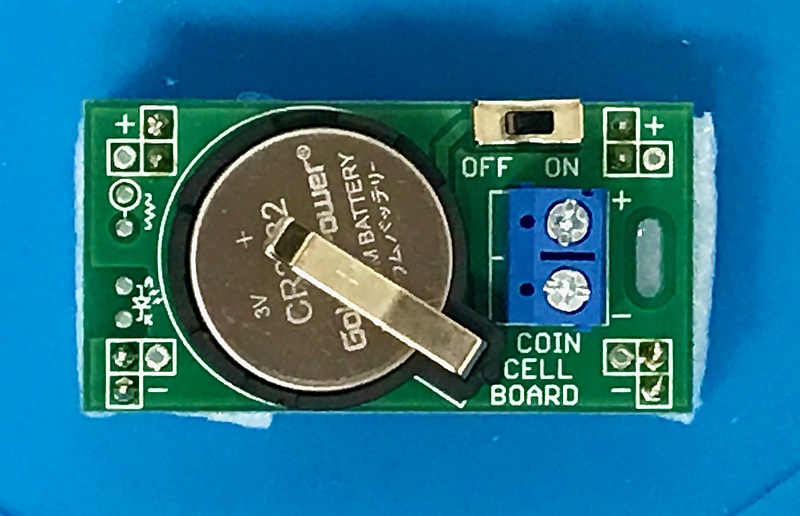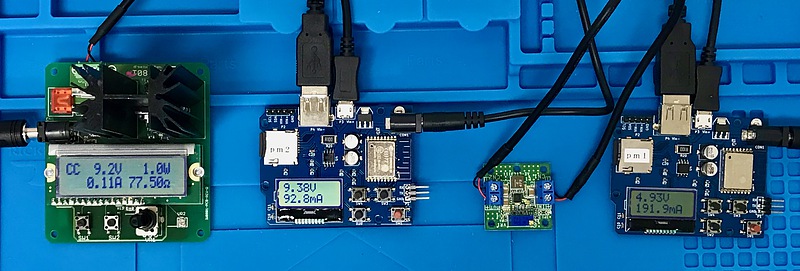Four DC/DC converter experiments
IoT devices need good DC/DC converters
For example, in order to drive a 5 V operation microcomputer or radio with a coin battery, a device that converts 3 V direct current (DC) to 5 V direct current is required. In addition, such DC/DC converters themselves that convert the supply voltage also consume power. An excellent DC/DC converter is required for IoT (Internet of Things) devices that are often operated by an independent power supply.

In recent years, DC/DC converters with various features have appeared. This time, I tried four unique DC/DC converters.
LMR562421
Texas Instruments’ LMR562421 is a step-up DC/DC converter that can output a high voltage up to 24 V from a low input voltage.
The specified input voltage range is 2.7 V to 5.5 V and the output voltage range is 2.5 V to 24 V. Typical conversion efficiency is 90%, typical output power is 9W.
The experiment used one experimental power supply with current limitation, two voltage and current measuring instruments, and an electronic load.

From the right to the left of the figure, the input voltage ammeter, DC/DC converter, output voltage ammeter, and electronic load are arranged. The experimental power supply is not shown in this photo.
The input voltage was 4.93 V and the input current was 212.5 mA, so the input power was 1.05 W. On the other hand, its output voltage was 14.98 V and its output current was 60.0 mA, so the output power was 899 mW. Therefore, the conversion efficiency is estimated to be 86%.
This volt-ammeter measures current with a voltage drop across a 100 milliohm resistor connected in series internally, resulting in a 100 millivolt drop per ampere. In addition, since the USB connector is used for input and output according to the specifications of the voltmeter, loss due to the wiring may be considered, so this conversion efficiency is estimated to be low. In addition, the voltage input to the DC / DC converter, the output voltage from the DC/DC converter, and the current value to the electronic load can also be changed, which can change the conversion efficiency. Therefore, this value is a reference value.
The display value of this output voltage ammeter and the display value of the voltage and current of the electronic load were slightly different. When I measured the voltage with a multimeter, the volt-ammeter display seems to be correct. This electronic load has a CC (constant current) mode in which a specified constant current load is applied and a specified constant resistance (constant registance) mode, but this time the CC mode was used.
LTC3111
Linear Technology’s LTC3111 is characterized by its ability to buck-boost a wide range of voltages from 2.5V to 15V. The input voltage range is 2.5 V to 15 V, and the output voltage range is 2.5 V to 15 V. A maximum output of 1.5 A is possible. It also has overheat protection and overcurrent protection.
The DC/DC converter can start from a voltage as low as 2.1 V, but this voltage can be changed by an external resistor. It is convenient to set the discharge end voltage (2.5 V) of one lithium battery cell to prevent over-discharge of the battery.

In this measurement, the input power was 946 mW, the output power was 870 mW, and the conversion efficiency was 91%.
OKL-T6-W12C
Murata’s OKL-T/6-W12C is characterized by stepping down the voltage, high power output up to 6 A, and fast follow-up to load changes. The input voltage range is 4.5 V to 14 V and the output voltage range is 0.9 V to 5.5 V. In addition, there are short circuit, output current protection, and overheat protection functions, so you can use it with confidence.

The input power was 664 mW, the output power was 405 mW, and the conversion efficiency was 61%. This DC / DC converter may have had disadvantageous conditions such as low input voltage, high output voltage, and light load.
TPS7A4700
Texas Instruments’ TPS7A4700 features a wide output voltage range from 1.4 V to 20.5 V that can be digitally set in 100 mV increments and low output noise of 4.17 microvolts. The input voltage range is wide and convenient from 3 V to 35 V. Maximum output current is 1 A. It also has a current limit and thermal shutdown function, so you can use it with confidence.

The input power at this time was 508 mW, the output power was 310 mW, and the conversion efficiency was 61%.
Conclusion
Until now, electronic work has used a drop type DC/DC converter that heats the voltage drop of the 7805 or the like, or an otherwise easy AC power adapter, but in this experiment switching type DC/DC I saw the evolution of the converter.
In this experiment, attention was paid to overvoltage inputs and overloads, so no attention was paid to the actual performance of the DC/DC converter.
I would like to utilize these devices in the future.